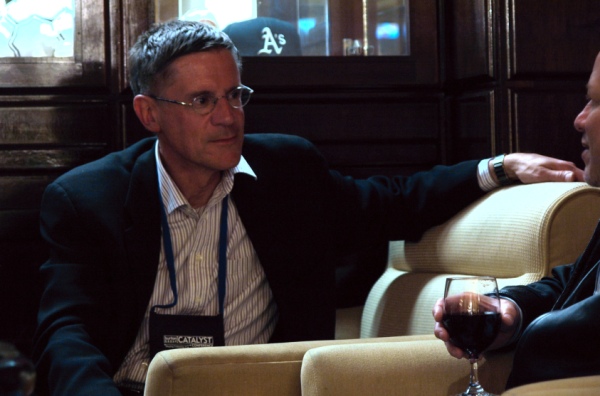 The Catalyst Conference last week was a great event. The Burton Group has a way of combining solid technical information with social interaction and humor to make a very potent experience. The speakers’ analysis of industry needs and trends was insightful and useful, as usual. Significant collaboration happened in the hallways and after hours in local restaurants and bars.
The Catalyst Conference last week was a great event. The Burton Group has a way of combining solid technical information with social interaction and humor to make a very potent experience. The speakers’ analysis of industry needs and trends was insightful and useful, as usual. Significant collaboration happened in the hallways and after hours in local restaurants and bars.
A particularly proud moment this year for me was convincing my son to drive up from San Jose and crash the opening reception with me. I’m sure it was not very pleasant for him at first, but he survived, nodded at appropriate moments, was relatively polite, and didn’t argue too vigorously with my stories about him. Thanks JT.

It was great to get reacquainted with Craig Burton, as well as get a chance to converse with Jamie and the whole Burton Group crew. Of course, the place was packed with the card carrying members of the Identity Gang. I was so surprised to come around a corner and run into Pete Rowley that I exclaimed “good to see you, Phil!”. Social competence has never been my strong point. Sorry Phil, er, Pete.
 On Wednesday I participated in a panel discussion entitled: “Protocol Preferences Aside: How’s All This Stuff Going to Work Together?” I had been very hesitant about it since the other panel members represented large Internet access and federation service providers, whereas I represented small Open Source identity management projects. The moderator, Bob Blakley, and the audience asked great questions and I thought the discussion was actually enjoyable (which is not what I usually feel on stage). My fellow panel members were very engaging and we found that we are all trying to make Internet identity systems work together, and willing to listen and learn. I hope the audience found it as helpful as I did.
On Wednesday I participated in a panel discussion entitled: “Protocol Preferences Aside: How’s All This Stuff Going to Work Together?” I had been very hesitant about it since the other panel members represented large Internet access and federation service providers, whereas I represented small Open Source identity management projects. The moderator, Bob Blakley, and the audience asked great questions and I thought the discussion was actually enjoyable (which is not what I usually feel on stage). My fellow panel members were very engaging and we found that we are all trying to make Internet identity systems work together, and willing to listen and learn. I hope the audience found it as helpful as I did.
But, by far, the most significant event for me was the “User-Centric Identity Management Interoperability Demonstration“. The event was sponsored by the Burton Group and many projects associated with the OSIS working group of the Identity Commons participated. The Bandit team had been working for months to support the interoperability event. We had Bandit entries in the Identity Provider and Relying Party functional areas, and we supported the DigitalMe identity selector that we had contributed to the Higgins project.
The event showed:
- 11 Identity Providers from 10 different vendors/projects
- 6 Identity Selectors from 4 different vendors/projects
- 24 Relying Party components from 16 different vendors/projects
Unfortunately, the Bandit Project’s participation was omitted from the press release and the Burton Groups’s web site, and much that has been written about the event does not list the Bandit project as a participant. I’m sure it was an oversight but that one aspect was very uncool.
Overall, the event showed very significant progress in implementations of these types of identity systems. The most productive aspect was the collaboration with other projects in preparation for the event itself.

And it was fun to see it work. While there were many bugs and hiccups along the way, diverse projects pulled together and did the real work of making it work. The vast majority of projects represented were able to successfully interoperate with other components of the distributed identity system. A subtle shift happened in our thinking as well. We began to think about the system in more social, relational, and powerful ways. I’ll write more on that later.
Now we’re looking to a more rigorous testing phase and what we can learn from real deployments.
And, of course, we’re looking forward to the next Catalyst.